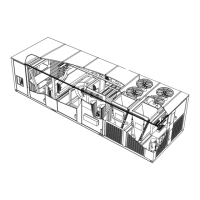Page 37
507232-04 7/2017
5- Turn gas valve switch to OFF. See figure 33. On
Honeywell VR8305Q gas valves, turn the knob on the
gas valve clockwise
to “OFF”. Do not force. See
figure 34.
6- Wait five (5) minutes to clear out any gas. If you then
smell gas, STOP! Immediately call your
gas supplier from a neighbor's phone. Follow the gas
supplier's instructions. If you do not smell gas, go to the
next step.
7- Turn gas valve switch to ON. See figure 33. On
Honeywell VR8305Q gas valves, turn the knob on the
gas valve counterclockwise
to “ON”. Do not force.
See figure 34.
8- Close or replace the heat section access panel.
9- Turn on all electrical power to appliance.
10-Set thermostat to desired setting.
11- The ignition sequence will start.
12-If the appliance does not light the first time (gas line not
fully purged), it will attempt up to two more ignitions
before locking out.
13- If lockout occurs, repeat steps 1 through 10.
14- If the appliance will not operate, follow the instructions
“Turning Off Gas to Appliance” and call your service
technician or gas supplier.
Turning Off Gas to Unit
1- If using an electromechanical thermostat, set to the
lowest setting.
2- Before performing any service, turn off all electrical
power to the appliance.
3- Open the heat section access panel.
4-Turn gas valve switch to OFF. On Honeywell VR8305Q
gas valves, turn the knob on the gas valve clockwise
to “OFF”. Do not force.
5-Close or replace the heat section access panel.
Gas Heat Operation and Adjustments
A-Heating Sequence of Operation
1- On a heating demand the combustion air inducer starts
immediately.
2- Combustion air pressure switch proves inducer
operation. After a 30-second pre-purge, power is
allowed to the ignition control. Switch is factory set and
no adjustment is necessary.
3- Spark ignitor energizes and gas solenoid valve opens.
4- Spark ignites gas, ignition sensor proves the flame and
combustion continues.
5- If flame is not detected after first ignition trial, ignition
control will repeat steps 3 and 4 two more times before
locking out the gas valve.
6- For troubleshooting purposes, an ignition attempt after
lock out may be re-established manually. Move
thermostat to “OFF” and return thermostat switch to
“HEAT” position.
B-Limit Controls
Limit controls are factory-set and are not adjustable. On
downflow air discharge units, the primary limits (S10 and
S99) are located under the collector boxes. On horizontal
air discharge units, the primary limit (S10)is located on the
blower deck at the rear of the unit.
The secondary limit (S21) is used for both heat sections
and is located in the blower compartment.
C-Heating Adjustment
Main burners are factory-set and do not require adjustment.
The following manifold pressures as listed on gas valves:
Natural Gas Units - Low Fire - 1.6” w.c.
(not adjustable)
Natural Gas Units - High Fire - 3.7” w.c.
LP Gas Units - Low Fire - 5.5” w.c.
(not adjustable)
LP Gas Units - High Fire - 10.5” w.c.
See Optional Modulating Gas Valve (MGV) section on units
equipped with MGVs.
Electric Heat Start-Up (LC Units)
Electric heat is a factory-installed option in LC units in
downflow air discharge applications only.
The Unit Controller will operate two stages of electric heat in
thermostat control mode. The Unit Controller will operate up
to four stages of electric heat in zone sensor or discharge air
control mode. Refer to the Unit Controller manual provided
with unit. Refer to electric heat wiring diagram on unit for
sequence of operation.

